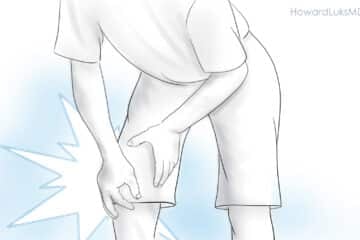
Ankles pop and snap for many reasons. Ankle injuries are very common. Some ankle injuries lead to popping or snapping. Sometimes ankles snap and pop without an injury. The most common ankle injury is an ankle sprain. That involves an injury to at least one of the ligaments holding the bones around the ankle together. If the ligaments in your ankle remain loose the popping you feel might be due to the bones moving around more than usual because the ligaments are stretched or weak.
Under many circumstances snapping or popping of the ankle is not a worrisome issue. We are going to review occasions where your ankle should be evaluated and thoroughly examined.
Why Do Ankles Pop or Snap:
The 4 most common reasons your ankle might snap or pop include:
- Ankle Instability due to a chronic ligament injury
- A tendon snapping over the bones – usually the Peroneal Tendons
- OCD or Osteochondritis Dessicans: A loose piece of bone is formed in the ankle
- Many ankles pop and snap and have nothing wrong on exam and MRI.
Peroneal Tendon Instability:
This issue involves instability of the peroneal tendons on the outside or lateral side of your ankle. The peroneal tendons wrap around the fibula or the little bone on the outside of the ankle. If these tendons are not held tightly against the bone they may snap or pop. Popping or snapping of these tendons can occur without injury if your ligaments are a little loose. True peroneal tendon instability often occurs after a severe ankle sprain. When you roll your ankle the structure that normally holds the peroneal tendons in place may also tear. If that “retinaculum” tears, then every time you move your ankle the peroneal tendons can slide out of their groove and over the end of the fibula. This will create obvious snapping or pop on the outer side of your ankle. This post goes into far more detail on peroneal tendon subluxation.
OCD or Osteochondritis Dessicans:
Another reason for your ankle to pop or snap is osteochondritis dissecans or OCD of the ankle. OCD of the ankle involves a bone in the ankle called the Talus. Under certain circumstances, a portion of the cartilage and the bone can become loose within the ankle joint. OCD of the ankle can occur after a severe injury. OCD of the ankle can also occur due to chronic repetitive stress. This is mostly seen in young patients. When you have had OCD of the ankle a piece of bone and cartilage is loose within the ankle joint. When you use of the ankle that loose piece of cartilage and bone moving around can give you the sensation of popping, locking or snapping.
Ankle Sprains:
One of the most common causes of ankle popping is instability of the ankle joint itself. This usually occurs in someone who has suffered many ankle sprains. Sprains involve an injury to the ligaments holding the ankle bones together. After multiple sprains, the ligaments are no longer as tight as they were before the initial injury. Therefore, when you change direction, move sideways, or pivot and twist the ankle bones might be coming apart leading to instability and popping or snapping of the ankle bones as they come back together.
Many patients with ankle instability will respond quite well to wearing a compression sleeve, physical therapy program or bracing with certain athletic activities. If you do not respond to nonsurgical measures then your sports medicine professional may need to tighten the ligaments to minimize the risk of instability.
For those suffering from osteochondritis dissecans or OCD of the ankle with a loose piece of bone we typically need to perform a procedure called an ankle arthroscopy. This involves putting a small fiberoptic camera into the ankle to visualize all the surfaces. Sometimes the loose piece is able to be put back into place and repaired. On occasion, the piece of cartilage is too beaten up to repair. In that situation, the loose piece needs to be removed. OCD injuries are usually small. If a large piece of bone is involved we may need to consider a cartilage regeneration procedure. The goal of the cartilage regeneration is to minimize the risk of developing osteoarthritis.
When instability of the peroneal tendons on the outer side of the ankle is caught early, a short period of casting or bracing might allow the structure holding the tendons in place to heal. When bracing or casting does not work, then surgery to repair the structure holding the tendons in place will be needed to hold the peroneal tendons in place. If those tendons are allowed to snap and pop over the end of the fibula they might eventually tear if this injury is not addressed surgically.
As mentioned above, the most common cause of ankle popping or snapping is unknown. That means that your examination and an MRI may not reveal any obvious abnormality. Hopefully, a good exam and a good discussion with your doctor can explain why your ankle pops and put your mind at ease.













I’m going into high school next year, and I’ve been working out during the off season of soccer to prepare for varsity or junior varsity. Every time I jump, rotate my ankle (in warmups) or go up stairs fast, my ankle makes a little snapping or popping sound. I feel no pain, but have noticed it for about a month. I’ve never had an ankle injury before. Do I go to a doctor, or is it fine?
Many ankles snap and pop and it is “normal” in most instances. The only way to tell for sure is to be examined. So, if you or your parents are concerned and want the comfort of knowing that this is not a problem then you can see a sports doc or a foot and ankle doc.
Good luck
My ankles have always been pretty weak. They twist and sprain very easy but I’ve been in sports all my life so that doesn’t bother me. However my ankle has been popping lately and it hurts pretty bad then my toes feel like they are going numb, then everything will be fine until it happens again. Any suggestions on what to do?
I would see a sports medicine doc, perhaps one who specializes in ankles. Many people have “instability” where the ligaments are loose. That might explain your issues. Often times physical therapy is beneficial at making the ankle feel a lot more secure and stable.
I hurt my ankle last year and I went to the doctor she said I had a high ankle sprain with deep bruising she put an air brace on it told me to go home and walk on it but now everytime I walk it feels like my ankle is slipping sideways and pops when I move it and it’s very painful when it pops what would cause this to happen
You should try and see a sports doctor who treats ankles. Recurrent instability of peroneal tendon subluxation can cause snapping.
I’m 14 and sometimes have an ache mainly in my left ankle/foot usually at night and after/during workouts (I play field hockey and ice hockey). My mom is a nurse and says I’m fine and it’s nothing, but how do I know if it’s actually nothing? She brushes off every injury, like when she broke her toe and didn’t wear a cast or boot. It’s also been so many years, almost 5, and I don’t know how to tell her if it’s not just nothing and she’s wrong because she’ll probably say if I’ve survived it this long I must be fine. What should I do and is it really all in my head?
It also pops and hurts a bit when I rotate it and I’ll very occasionally have flashes of pain that go away immediately (sorry for the add-on)
Add-ons are fine :-) “Peroneal tendon subluxation” can cause a painful snapping on the outer side of your ankle… a good physical exam would reveal if that is what’s going on. There are other things that can cause painful snapping too… that’s why you should see someone for a good exam and some xrays.
HI Natalie !!! IT’s not in your head. There are many foot/ankle conditions that show up in kids your age. A good examination and perhaps X-ray or MRI should be able to tell us what’s bothering you and then we can comment on what potential treatments are available.